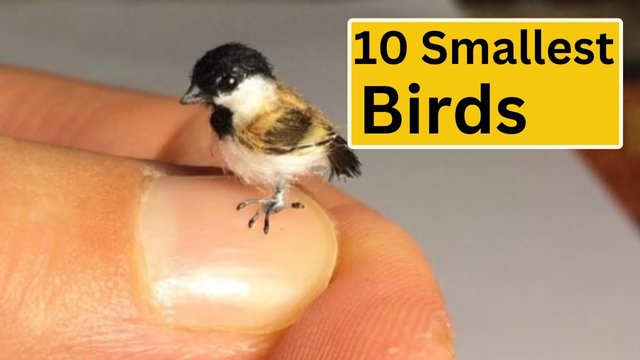Top 10 World's Smallest Birds
Imagine a world where the smallest creatures defy the odds with their vibrant colors, fascinating behaviors, and unparalleled agility - welcome to the realm of the tiniest birds on our planet.

These avian marvels captivate us with their sheer existence, proving that greatness often comes in small packages. In this exploration, we journey through the lives of the ten smallest birds in the world, delving into their habitats, lifestyles, and the significant roles they play in nature's grand tapestry.
The Fascination with Small Birds
Why Size Matters
In the avian world, being small comes with its unique set of advantages and challenges, from evading predators to finding niche habitats.
Small birds can exploit food sources that larger birds cannot, maneuver through dense foliage with ease, and require less to sustain their tiny bodies. Yet, their size also makes them vulnerable to harsh weather conditions and predators.
The Role of Small Birds in Ecosystems
Despite their diminutive size, these feathered friends play a crucial role in the balance of ecosystems, pollinating plants, and controlling insect populations. They are the unsung heroes of their habitats, ensuring the survival and proliferation of countless plant species, which in turn supports a diverse array of wildlife.
Criteria for Ranking: Understanding Bird Size
Measuring Bird Size
Determining the 'smallest' bird involves considering various factors, including weight, length, and wingspan. It's a complex task that requires careful measurement and comparison, often leading to fascinating discoveries about these tiny creatures' adaptability and evolution.
Challenges in Data Collection
Studying the smallest birds poses unique challenges, from their elusive nature to the scarcity of comprehensive data. Researchers must employ innovative techniques to observe, capture, and record the vital statistics of these minuscule beings, often in remote or dense habitats.
Top 10 Smallest Birds in the World
01. Bee Hummingbird
The Bee Hummingbird holds the title of the world's smallest bird, flitting through the forests of Cuba with astonishing grace. Weighing less than 2 grams, it's a marvel of nature, showcasing the extreme limits of avian size and agility.
02. Goldcrest
Roaming through the woodlands of Europe, the Goldcrest impresses with its minuscule size and vibrant crown. Despite weighing just around 5 grams, this bird's spirited song fills the air, a testament to its outsized presence.
03. Verdin
In the arid regions of North America, the Verdin thrives, a testament to the adaptability of small birds. Its ability to survive in such harsh climates while maintaining a diet of insects and small fruits is truly remarkable.
04. Weebill
Australia's smallest bird, the Weebill, is a master of camouflage in its woodland and forest habitats. Its name reflects its compact size, yet its presence is significant, contributing to the control of insect populations.
05. Costa’s Hummingbird
In the deserts of the southwestern U.S. and Mexico, Costa’s Hummingbird dazzles with its iridescent plumage. Its survival in such extreme climates is a testament to the remarkable adaptability of small birds.
06. Pardalote
Among the eucalyptus forests of Australia, the Pardalote flutters, contributing to the health of these towering trees. It plays a crucial role in controlling insect populations and spreading eucalyptus pollen.
07. American Goldfinch
Adorning the landscapes of North America, the American Goldfinch is a spectacle of color and resilience. Its diet primarily consists of seeds, making it a vital player in the dispersal of plant life.
08. Broad-billed Hummingbird
The Broad-billed Hummingbird thrives in the diverse environments of the southwestern United States with its vivid colors. Its diet supports local ecosystems by pollinating flowers and controlling insect populations.
09. Buff-bellied Hummingbird
The Buff-bellied Hummingbird navigates the warm climates of the southern United States and Mexico with ease. Its varied diet and adaptability showcase the resilience of small birds in diverse environments.
10. Wren
Wrens, with their compact bodies and loud songs, occupy diverse habitats worldwide, showcasing the adaptability of small birds. Their insectivorous diet plays a crucial role in maintaining ecological balance.
Conservation Efforts for Small Birds
Threats to Small Birds
From habitat destruction to climate change, the world's smallest birds face monumental challenges in their fight for survival. Their habitats are shrinking, and food sources are becoming more scarce, threatening their existence.
Conservation Success Stories
Despite these challenges, there are success stories of resilience and recovery, highlighting the importance of global conservation efforts. Initiatives to protect habitats, enforce hunting regulations, and educate the public have proven effective in safeguarding these tiny treasures of the avian world.
A Closer Look at Nature's Miniatures
As we delve into the lives of the smallest birds, we uncover stories of survival, ecological importance, and sheer beauty that inspire both awe and action. These tiny aviators remind us of nature's wonders and the critical need to protect our planet's biodiversity.
Call to Action
Supporting bird conservation efforts can ensure that these tiny aviators continue to thrive and enchant future generations. Whether through donations, volunteering, or simply spreading awareness, every action counts in the fight to preserve the natural world.
Frequently Asked Questions (FAQ)
Q: How can I help protect small birds?
A: Support conservation organizations, create bird-friendly spaces in your community, and advocate for policies that protect natural habitats.
Q: Are small birds endangered?
A: While not all small birds are endangered, many face significant threats that could lead to declining populations without intervention.
Q: Can I find these small birds near me?
A: Depending on your location, some of these birds might be native to your area. Research local birdwatching guides or join community groups to learn more.
Q: Why are small birds important?
A: Small birds play vital roles in ecosystems, including pollination, seed dispersal, and insect control, contributing to ecological balance and diversity.
By fostering an appreciation for the smallest members of the bird world, we can take steps to ensure their songs never fade from our planet's chorus.